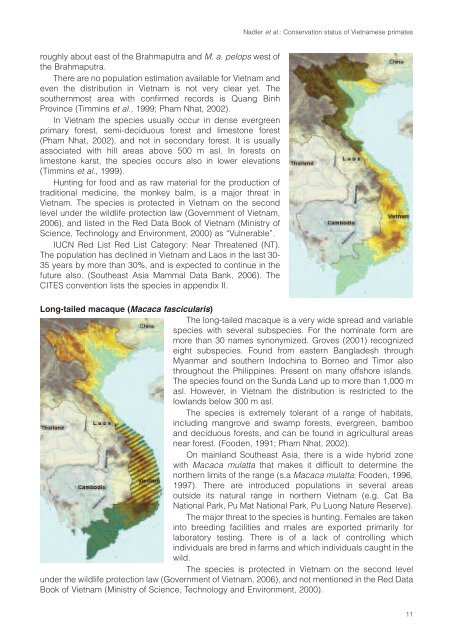Vietnamese Journal of Primatology - Frankfurt Zoological Society
Vietnamese Journal of Primatology - Frankfurt Zoological Society
Vietnamese Journal of Primatology - Frankfurt Zoological Society
You also want an ePaper? Increase the reach of your titles
YUMPU automatically turns print PDFs into web optimized ePapers that Google loves.
oughly about east <strong>of</strong> the Brahmaputra and M. a. pelops west <strong>of</strong><br />
the Brahmaputra.<br />
There are no population estimation available for Vietnam and<br />
even the distribution in Vietnam is not very clear yet. The<br />
southernmost area with confirmed records is Quang Binh<br />
Province (Timmins et al., 1999; Pham Nhat, 2002).<br />
In Vietnam the species usually occur in dense evergreen<br />
primary forest, semi-deciduous forest and limestone forest<br />
(Pham Nhat, 2002), and not in secondary forest. It is usually<br />
associated with hill areas above 500 m asl. In forests on<br />
limestone karst, the species occurs also in lower elevations<br />
(Timmins et al., 1999).<br />
Hunting for food and as raw material for the production <strong>of</strong><br />
traditional medicine, the monkey balm, is a major threat in<br />
Vietnam. The species is protected in Vietnam on the second<br />
level under the wildlife protection law (Government <strong>of</strong> Vietnam,<br />
2006), and listed in the Red Data Book <strong>of</strong> Vietnam (Ministry <strong>of</strong><br />
Science, Technology and Environment, 2000) as “Vulnerable”.<br />
IUCN Red List Red List Category: Near Threatened (NT).<br />
The population has declined in Vietnam and Laos in the last 30-<br />
35 years by more than 30%, and is expected to continue in the<br />
future also. (Southeast Asia Mammal Data Bank, 2006). The<br />
CITES convention lists the species in appendix II.<br />
Nadler et al.: Conservation status <strong>of</strong> <strong>Vietnamese</strong> primates<br />
Long-tailed macaque (Macaca fascicularis)<br />
The long-tailed macaque is a very wide spread and variable<br />
species with several subspecies. For the nominate form are<br />
more than 30 names synonymized. Groves (2001) recognized<br />
eight subspecies. Found from eastern Bangladesh through<br />
Myanmar and southern Indochina to Borneo and Timor also<br />
throughout the Philippines. Present on many <strong>of</strong>fshore islands.<br />
The species found on the Sunda Land up to more than 1,000 m<br />
asl. However, in Vietnam the distribution is restricted to the<br />
lowlands below 300 m asl.<br />
The species is extremely tolerant <strong>of</strong> a range <strong>of</strong> habitats,<br />
including mangrove and swamp forests, evergreen, bamboo<br />
and deciduous forests, and can be found in agricultural areas<br />
near forest. (Fooden, 1991; Pham Nhat, 2002).<br />
On mainland Southeast Asia, there is a wide hybrid zone<br />
with Macaca mulatta that makes it difficult to determine the<br />
northern limits <strong>of</strong> the range (s.a Macaca mulatta; Fooden, 1996,<br />
1997). There are introduced populations in several areas<br />
outside its natural range in northern Vietnam (e.g. Cat Ba<br />
National Park, Pu Mat National Park, Pu Luong Nature Reserve).<br />
The major threat to the species is hunting. Females are taken<br />
into breeding facilities and males are exported primarily for<br />
laboratory testing. There is <strong>of</strong> a lack <strong>of</strong> controlling which<br />
individuals are bred in farms and which individuals caught in the<br />
wild.<br />
The species is protected in Vietnam on the second level<br />
under the wildlife protection law (Government <strong>of</strong> Vietnam, 2006), and not mentioned in the Red Data<br />
Book <strong>of</strong> Vietnam (Ministry <strong>of</strong> Science, Technology and Environment, 2000).<br />
11
















